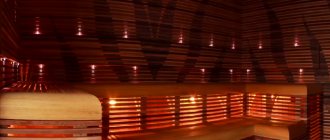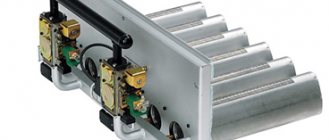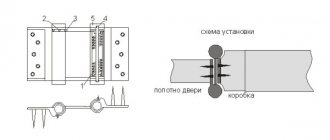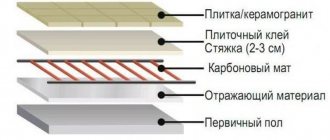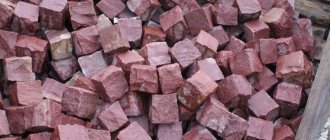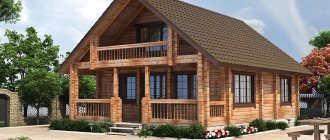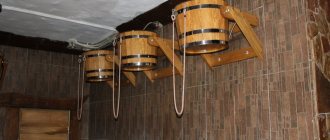Not every owner of a home bath can afford to use an abash for a bath. There are many restrictions on the use of various exotics in the steam room and washroom, but the mass use of new material is limited primarily by price. Apparently, there is something especially valuable and attractive in the texture of abasha wood, if over the past five years the demand for cladding has caught up with traditional linden and cedar.
Abasha varieties for finishing baths
Today, under the term “abash”, a special type of finishing wood with very interesting properties, specific texture and color is offered on the materials market. Currently, workshops and salons offer three options for valuable wood for cladding a steam bath:
- Board made of abacha or otherwise African oak, growing in the tropical massifs of West Africa, most often Nigeria and Cameroon.
- Lining made from Central Asian abashi, a relative of African wood, but having a looser structure and therefore sold at a lower price;
- Thermal board made of African and Asian wood, heat-treated in a chamber. As a result of calcination, the material acquires a red-brown color, becomes more durable, wear resistance increases, and resistance to pathogenic microflora improves.
Real abash has an inexpressive texture, the pattern of the fibers is practically not visible on the surface, so the material can be cut and sawed in any direction, there will be no “striations” in the finish of larch, spruce or pine. The color of African abasha wood can vary from almost white to cream. Asian wood is the lightest, African wood has a richer color.
Beware: fake!
Few people have not heard about the African miracle tree and its high cost, so it is not surprising that proposals for an Asian counterpart began to appear on the market, which is in no way inferior in quality, but will be cheaper.
But the abash tree has no brothers at all - it is one of a kind. Moreover, the latter should be taken literally - triplochiton durumis is the only representative of the genus Triplochiton.
Therefore, if we are talking about “Asian abasha”, then it must be some kind of analogue. Various sources say that this is either a silk tree, that is, a type of acacia (Albizia Lankaran), or Alstonia.
However, neither we are specialists in botany, nor are most of our readers. We have already found out above that, apart from low thermal conductivity, abashi has no particularly outstanding advantages. This means that a fake will be inferior to the original only if it has a higher density. Or if it is not suitable for a bath with high humidity .
Fortunately, checking the first is quite simple - find out the weight of a cubic meter of the Asian analogue and compare it with 350 kilograms of a cube of original wood dried to 12% moisture content.
But it’s good if you were at least warned that this is an analogue. But they can pass it off as an African abash. To prevent this from happening, focus on the color - the original have yellowness , it can be almost white, but with a tint, like butter. Or yellower, the color of straw. But the analog has gray shades together with yellow.
If you were offered cheap wood and you doubted it, think about this: maybe it’s better to take a well-known, easier to identify linden or aspen than an unknown exotic one?
The price of an abash, is it worth the candle?
To finish the bath, various forms of material are used, from slats and veneer to solid boards and timber. Most often, abashi for baths are sold at retail in the form of finished polished products - cladding and timber for sunbeds. The average cost of bench timber for a bathhouse, with a cross-section of 90x19 mm, is 5-6 dollars per meter, while lining with end locks, 85 mm wide, costs from 90 dollars per m2.
African “spill” Abashi timber and boards of similar sizes in wholesale cost 4-5 dollars per linear meter. For comparison, the price tag for a heat-treated version of an abashi board, 90 mm wide, starts at $10 per meter of length. Asian Abacha is usually quoted 15% cheaper than African Abacha.
When selecting abasha cladding for a bathhouse, you should remember that not all miracle wood offered on the market for construction and cladding products is the same in its characteristics. The African abasha tree grows up to 30 m tall, with a trunk girth of up to one and a half meters. Due to its enormous size, the abashi tree is cut and cut into a rough board directly at the harvesting site, so one wholesale batch may contain abashi boards with different characteristics.
For bath chairs and abash shelves, a board with maximum hardness is selected. It is best to select soft material for lining and finishing strips for cladding bath walls. It is difficult to find out exactly what material is in the wholesale packaging of abashi boards. No one will allow you to unpack a pack, sort and select a board before purchasing, so purchasing materials from abash wood for a bathhouse remains in many ways a lottery.
Only a professional who has been working with wood for many years can distinguish the difference in material. The average buyer, as a rule, purchases small quantities of lining and timber at retail, so he begins to understand the differences in characteristics only 2-3 years after intensive use of the bathhouse and steam room.
African tree: myths about abasha
But it’s worth starting with the heresy that we happened to read on the topic before we decided to write this article. Some statements are simply shocking... with the ignorance of the writers.
So, what do those who strive to advertise the product at any cost say?
The main emphasis, of course, is on the fact that you won’t get burned if you sit on the shelves in a steam room heated to sauna temperatures without a towel or sheet.
And then they begin to tell you how hard and dense the tree is, how easy it is to process and how resistant it is to various mechanical influences.
Someone will add that this African bathhouse tree does not rot at all and is extremely resistant to fungi .
It is also called oak - solely for marketing reasons, one must assume. Because those who call it "maple" at least do so because of the similarity of the leaves in shape to maples. And abashi has nothing in common with oak at all.
So, let's summarize. The main trick of the “sellers” is that something good in one thing must be made good in everything, and real dignity must be brought to a superpower. Elementary illiteracy can be added to this.
Abash for a bathhouse can be really good, although it is also important here - for what kind of bathhouse: Russian or Finnish? Because you won’t be able to get burned in Russian. Otherwise, wood is like wood - it burns and rots, it is stable according to its hardness class and nothing more.
What is important to know about abasha wood
The high price of finishing abash is completely justified, given the characteristics and unusual properties of African oak wood. In terms of “professional suitability” as a material for finishing bathhouses, African oak can only be compared with linden, which is just as light and pleasant to the touch. Abacha stands out from all known wood species according to several criteria:
- The low density of wood is successfully combined with high strength. Abash is not without reason called African oak; the material can withstand bending and twisting loads very well. It is much more difficult to split an abasha board than a spruce or pine board;
- No shrinkage processes under conditions of variable humidity and high bath temperatures. Even with a sharp change in temperature, abacha wood does not chip or crack, as often happens with cedar lining;
- Low water absorption and thermal conductivity of abasha wood. The treated surface of African oak, when contacted or touched by hand, in the hot atmosphere of the bathhouse, is tolerated by a person painlessly and even comfortably.
Important! African oak can rightfully be called a carpenter's dream. There are no knots in solid wood, there is no pronounced fiber structure, pliable wood cuts like butter, and is perfectly sanded and polished. Abasha wood is ideal for decorative finishing of a bathhouse, if not for the high price.
Asian abash has a more airy structure, so the material is either sent for heat treatment, or it is cut into veneer and used as cladding for the least important areas of the bathhouse.
Advantages and disadvantages
Let us highlight the main advantages and disadvantages of abasha for a bath.
Advantages:
- low thermal conductivity;
- low density;
- low humidity;
- durability;
- absence of resins;
- contains essential oils with a pleasant smell;
- beautiful tree pattern;
- almost complete absence of knots;
- it is impossible to get a splinter;
- the wood does not burst or crack;
- does not deform;
- easily tolerates changes in humidity and temperature.
Flaws:
- susceptibility to fungal attack (additional treatment required);
- high cost in Europe;
- a large number of fakes;
- difficulty finding high-quality processed material;
- not suitable for allergy sufferers due to the high content of essential oils and other components.
The most important factor influencing the quality of the material is the primary processing of wood.
Wood is exported to Europe from West African countries (Ghana, Cameroon, Nigeria, Côte d'Ivoire), and in this region the technology and quality of labor are not the most advanced. Therefore, a tree may arrive to us with flaws that only a specialist can determine.
Main advantages of using abash
The excellent strength and mechanical characteristics of wood would be enough to become the number one material on the list of the most popular materials for arranging a bathhouse. Oddly enough, this factor is ranked last among experts in the list of advantages of African oak. What is more important is comfort and safety.
True connoisseurs of a good steam room or sauna prefer abasha finishing for two reasons:
- The polished surface of the abasha is quite pleasant and comfortable to the touch in a hot sauna and does not burn like aspen or conifers. Steam room lovers claim that the feel of abashi shelves can be roughly compared to pressed foam plastic, just as dense and cooler;
- Real African oak, grown in a tropical rainforest, has good antiseptic properties. Therefore, the shelves in the sauna or steam room, even with a large number of visitors to the steam room, do not accumulate pathogenic microflora.
To understand how different Abash is from other types of wood, you can compare the density and thermal conductivity of the materials. The density of the popular linden is 530 kg/m3, that of noble alder is 490 kg per cubic meter, and that of aspen one cubic meter weighs 510 kg. For African abasha, this figure is 390 kg/m3. The differences in the numbers speak for themselves.
What's in reality?
In reality, this is a fairly common tree species in West Africa, which precisely because of its prevalence cannot be too expensive. But, as they say, “a heifer is half a heifer overseas, but a ruble is transported.”
Without going into botanical subtleties, I would like to clarify that abash is closer in relation to ordinary mallow, and not at all to oak or maple. It’s just that in Africa, mallows managed to grow into large trees.
Now let's start dealing with errors. Why is it believed that abashi is a tree for bathing? Because it has low thermal conductivity and heat capacity .
In the case of wood, these characteristics will depend on the density of the species, and the density depends in part on the porosity and bound water within the fibers. IMPORTANT! The lighter the wood, the lower its density, the less it heats up.
But the lower the density, the lower the hardness! But for some reason this point does not seem obvious to many. Hardness is the resistance of a material to the penetration of another body. In what case will it be higher: when the structure is loose or when it is dense?
Here is larch - dense, heavy wood. Very difficult to process. But linden is soft, light, and can be processed even with an ordinary knife. Abashi in this case is much closer to linden. Which, by the way, is confirmed by the words of the sellers themselves, who say that abash is easy to process.
In wood, density and hardness are partly related to how well the wood will resist rotting. Because it’s easier for mushrooms to eat soft and light ones (we’ll add, which don’t contain resin).
But by the way! Abash has average resistance to rotting caused by fungi. This is better than linden and aspen.
Further. Let's compare the characteristics of such popular bathhouse species as linden, aspen and abash!
Technical characteristics and properties
| PROPERTIES | LINDEN | ASPEN | ABASH |
| Average density | 490–530 kg/m³ | 450 kg/m³ | 350 kg/m³ |
| Density limits | 320–600 kg/m³ | 360–600 kg/m³ | 320-700 kg/m³ |
| Longitudinal shrinkage | 0,3 % | 0,4 % | no data |
| Radial shrinkage | 5,5 % | 3,3 % | 3,3% |
| Tangential shrinkage | 9,1 % | 8,2 % | 5,6% |
| Radial swelling | 0,15–0,23 % | 0,13 % | no data |
| Tangential swelling | 0,24–0,32 % | 0,25–0,31 % | no data |
| Flexural strength | 90-106 N/mm² | 76 N/mm² | 52 N/mm² |
| Compressive strength | 44-52 N/mm² | 36 N/mm² | 30 N/mm² |
| Tensile strength | 85 N/mm² | 69 N/mm² | no data |
Please note that the indicators of abasha are closest to aspen .
And it cannot be said that aspen is much inferior to it (in some ways it is even superior to abash). Separately, we present another plate that shows resistance to biological damage.
Pay attention to the paragraph that talks about fear of dampness - this is a reason to think about whether you have good ventilation .
In addition, it is worth mentioning that despite good nailability , the abash does not hold fastenings well . However, it sticks together perfectly .
And a little more about wood. The core and sapwood of abasha are practically indistinguishable from each other in color. But sapwood has a property - it is easier to rot and become infected . Consequently, some of the material will obviously be more vulnerable; maybe it’s worth thinking about impregnating it with at least oil or wax? Antiseptics are also used to prevent rotting. In addition, manufacturers offer wood that has undergone industrial impregnation - impregnated.
conclusions
Well, firstly, its thermal conductivity low, judging by the fact that its cube is one hundredweight lighter than an aspen cube.
Oddly enough, but abash, in our opinion, is very close to the properties of poplar (aspen is a type of poplar). Although some characteristics are, of course, better.
The good news is that it warps and cracks little or moderately. And in general, his performance is quite average. It takes only low thermal conductivity.
IMPORTANT! In this situation, only sauna owners need it. And even then, a towel may well make you insensitive to its absence.
In general, good top-class aspen is a worthy competitor to abashu in a steam room.
Where is it best to use African oak in a bath?
It is clear that each type of wood has its own advantages and disadvantages, and abasha also has them. In addition to the high price, one has to take into account the too low hardness of the wood. It cannot be filled with nails or self-tapping screws; the bathhouse floor made of abasha is quickly pressed through by heavy furniture or a stove. Shelves, hooks, and hangers cannot be hung on the walls of the bathhouse, lined with African and especially Asian abacha.
In addition, when finishing a bathhouse, you must be careful when handling expensive cladding; any blow with a tool, hammer, or careless movement with a saw leaves deep cuts and dents.
According to reviews from owners of steam rooms for baths, the use of Asian or West African abacha is justified only in three cases:
- If a dry and very hot atmosphere is created in the steam room of the bath, using the shelves, especially the top row, becomes extremely difficult due to the hot surface. An abash is ideal for a sauna, less so for a Russian steam room, and there is absolutely no point in laying an abash on a shelf for a Turkish bath.
- Children often visit and play in the steam room and in the waiting room of the bathhouse. The soft wood of African oak does not cause splinters and cuts, even if you walk or run on it barefoot;
- In case the floors in the steam room regularly rot and fail. This happens if the ventilation of the bathhouse and steam room is not done correctly, the corner areas of the room do not dry out and do not get rid of moisture.
Often, abasha is used to make insets into the floor near the heater, and lay wooden grates on which you can freely step with bare feet. An interesting option is the use of abasha for lining the floor of the washing compartment of the bathhouse. Tile is considered slippery and unsafe, rubber mats are not aesthetically pleasing or hygienic, but an abasha grate will last in the shower for as long as you like and looks nice.
It is believed that in the steam room of a Russian bath, expensive wood is too quickly saturated with water, condensation, and the smell of birch brooms and herbs used in bath procedures. Abacha wood is indeed more active than any other wood in absorbing odors and substances. Therefore, with soap, modern detergents, and even more so exotic honey, chocolate, and mud skin care products, entry into the steam room of the bathhouse is strictly prohibited.
Abasha lining can be used in the steam room of any bathhouse, the only condition is that after completing the session, the lining is washed with clean water and a linen washcloth to remove dirt and traces of sweat.
Lining installation technology
Abash lining is perfect for a bathhouse. You can install it yourself. To do this, you can use slats. They allow you to cover walls quite quickly and efficiently. If you need to update the surface, you can do it without difficulty.
Each subsequent lining board is installed in the groove of the previous one, and a galvanized clamp, which is a special clamp, is put on the protrusion. It is fixed to the sheathing batten with a screw and a self-tapping screw or a galvanized nail. Abashi for a bath, the price of which is quite high, is installed using a certain technology. At the final stage, it involves trimming the last product so that the craftsman has the opportunity to freely insert the panel into the remaining space. Fastening is carried out with nails or self-tapping screws.
Is the smell of abasha suitable for a bath?
One of the reasons why African oak wood has not yet replaced linden is the unusual smell of fresh wood, not very pleasant and quite persistent. Traditional methods of struggle - warming up and frying the steam room before putting the bathhouse into operation - help little.
The unpleasant smell disappears after 4-5 weeks of using the steam room, and until this point you have to use blocks of freshly sawn cedar laid next to the heater. The smell of cedar removes and masks abacha fumes. Sometimes, fresh wood is treated with linseed oil, which helps protect the wood from stains and reduces the intensity of the odor.
If a radical solution is required, then heat-treated material can be used. The thresholds and corner slats of the bathhouse shelves are made from hardened Asian abacha, handles and parts of the cladding located in close proximity to the heater and ventilation system are cut out. And although African oak wood is not prone to rotting and warping, heat treatment can increase the durability and service life of the cladding up to 20 years.
Using nails during installation
Abash lining for a bath, the price of which is 270 rubles. per linear meter or 3240 rubles. per square meter, can be installed using nails. However, it should be borne in mind that this approach quite often leads to marriage. It is difficult to imagine that not a single element will be damaged in this case.
If the length of the lining is 2.5 m, then you will have to hammer in approximately 6 nails with a product width of 100 mm. If you are going to cover a wall whose length is 10 m, then you will need 600 pieces. The master must have special skills to carry out the work without defects. The nail should be inserted into the groove and driven further into the mounting rail. The cap is recessed inside with a hammer so that it does not interfere with the installation of the next element.
When choosing abashi for a bath, the price should definitely be taken into account. For example, an extra grade thermal material will cost you 325 rubles. per linear meter or 3900 rubles. per square meter. In this case, as in the previous one, we are talking about products whose dimensions are 12 x 92 mm.
How to make shelves from abasha
So, the wood of the species in question is used in baths and saunas as cladding, as well as material for shelves and bath furniture. The sheathing can be purchased in the form of lining, but you will have to make the shelves yourself from boards.
Before you start making them, you should make a drawing of the future design.
The dimensions of the shelves should be taken into account:
- The minimum length of the bench should be 150-180 cm;
- Height - at least 20 cm from the floor and at least 40-60 cm between levels. The distance between the ceiling and the upper bench should be at least 100-120 cm.
- The width can be from 40 to 150 cm, depending on the size of the steam room and the preferred resting position.
Frame for shelves
Advice! Before making the structure, boards and beams should be carefully sanded and sharp corners smoothed.
The instructions for making shelves for a bathhouse are extremely simple:
- First of all, you need to assemble the frame. To do this, you need to make several support posts from timber with a cross-section of 50x70 mm, install them in a vertical position and fasten them horizontally with strapping. To prevent the flooring from sagging, the racks should be installed at a distance of no more than 50-60 cm.
- Then you need to make benches from thin abashi boards, nailing them to the frame with a gap of several centimeters. To ensure free flow of water, benches should be tilted at one to two degrees.
Note! It is prohibited to use synthetic antiseptic compounds for treating wood, since harmful toxic elements can evaporate under the influence of high temperatures.
The parts should be connected using wooden wedges, which are driven into pre-prepared holes. When using traditional self-tapping screws, they are deepened into the wood to a depth of 5-6 mm to prevent the possibility of burns.
Two-tier benches
